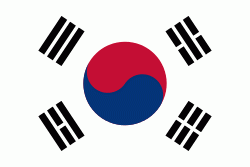Cheonan
 |
 |
Cheonan has a population of 666,417 (2018), making it the most-populous city or county in South Chungcheong, and the third most-populous city in the Hoseo region after Daejeon and Cheongju. Cheonan borders the Gyeonggi cities of Pyeongtaek and Anseong to the north, the South Chungcheong cities of Asan to the west and Gongju to the southwest, Sejong Special Autonomous City to the south, the North Chungcheong city of Cheongju to the south east and Jincheon County to the east.
Cheonan has been called "the core city of [the] nation" due to its location 83.6 km south of the national capital, Seoul, in the northeast corner of South Chungcheong, serving as a transportation hub to the Seoul Capital Area and surrounding regions. Cheonan is connected to various freeways and railways including the National Highways 1 and 21, the Expressways 1-Gyeongbu and 25-Honam, and the city's Korail station serves the Gyeongbu Line and the Janghang Line, with services of the KTX. Cheonan is one of the furthest places from Seoul connected to the Seoul Subway Line 1.
Cheonan has always been a major transportation hub of Korea because of its proximity to Seoul and its location near a gap in the eastern mountain range (Charyeong Range) that allows passage through to the major southeast centers of Daegu and Busan. Cheonan's Samgeori (meaning “3-way intersection”) park has been noted as a strategic point of transportation and a place where culture has spread for a long time. It is the place where Samnamdaero, which starts in Seoul, parts, leading one branch of the road through to the south-eastern Yeongnam region (which includes Gimcheon, Daegu, Gyeongju and Dongnae), and leading the other through Gongju and Nonsan to the Honam region (which includes Jeonju, Gwangju, Suncheon, and Yeosu).
Due to its strategic location, Cheonan has also been an important postal center where early communications from the south converged before heading to Seoul, or where messages from the capital diverged into the southern regions. More formal and structured mail services later emerged with the construction of the city's first postal outlets, and the entire history of mail service in Cheonan (and in South Korea in general since 1883) is now on display in the country's largest postal museum in Yang-ji-mal in eastern Cheonan.
Cheonan was a relatively small town for much of the early half of the 20th century. As a transportation center, it was the site of an early engagement in the Korean War, the Battle of Cheonan. Then, in 1963 three municipal districts in the area that were growing in size were merged and promoted to the category of si, meaning city, by order of Law No 1176. Thus the City of Cheonan was born, comprising the populations of Cheonan-gun, Cheonan-eup and Hwanseong-myeon. Over the next two decades, the city grew in size by incorporating neighboring populations, including that of Byeongcheon-myeon in 1973. In 1975 the city renamed 10 branch offices to 10 dongs, representing the major administrative regions of the city. The city continued to expand, absorbing neighboring ri, myeon, and eup, including Pungse-myeon and Guryong-ri in the early 80s. Throughout this time, new neighborhoods to the southwest that were collectively known as Cheonan-gun, such as Ssangbong-dong, also grew in population, and in 1995 Cheonan-gun and Cheonan-si were merged into one large Cheonan-si. Larger dong that comprised the city were subsequently separated into smaller factions, such as Ssangbong-dong into Bongmyong-dong and Ssangyong, which itself was later separated into Ssangyong 1(il)-dong and Ssangyong 2(i)-dong (and then again into Ssangyong 2(i)-dong and Ssangyong 3-dong in 2003). In 2002 a city ordinance promoted the northern fringe village of Jiksan-myeon and the southern fringe village of Mokcheon-myeon into Jiksan-eup and Mokcheon-eup. This extended the boundaries of the city to a span of approximately 16 kilometers from north (at Jiksan) to south (at Mokcheon), and about 12 kilometers from Sunmoon University in the west to Mount Taejo on the eastern fringe. Including all of its administrative regions (see below), the city now covers a total area of 636.25 km2.
Map - Cheonan
Map
Country - South_Korea
 |
 |
| Flag of South Korea | |
The Korean Peninsula was inhabited as early as the Lower Paleolithic period. Its first kingdom was noted in Chinese records in the early 7th century BCE. Following the unification of the Three Kingdoms of Korea into Silla and Balhae in the late 7th century, Korea was ruled by the Goryeo dynasty (918–1392) and the Joseon dynasty (1392–1897). The succeeding Korean Empire (1897–1910) was annexed in 1910 into the Empire of Japan. Japanese rule ended following Japan's surrender in World War II, after which Korea was divided into two zones; a northern zone occupied by the Soviet Union and a southern zone occupied by the United States. After negotiations on reunification failed, the southern zone became the Republic of Korea in August 1948 while the northern zone became the communist Democratic People's Republic of Korea the following month.
Currency / Language
| ISO | Currency | Symbol | Significant figures |
|---|---|---|---|
| KRW | South Korean won | â‚© | 0 |
| ISO | Language |
|---|---|
| EN | English language |
| KO | Korean language |















